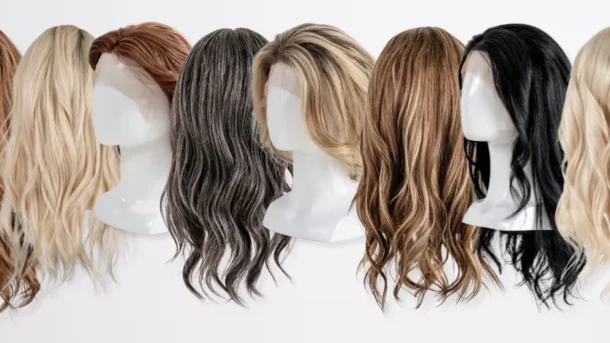Hair loss, hairstyle changes, or simply pursuing styling diversity have made wigs a popular choice for more and more people. Statistics show that the global wig market has exceeded $10 billion, yet 60% of consumers end up with unused wigs due to poor choices. This guide systematically explains wig materials, craftsmanship, wearing scenarios, and purchasing tips to help you find a natural, comfortable ideal hairstyle.

I. Wig Types: Match Your Needs
1. By Coverage Range
| Type | Suitable Scenarios | Advantages | Disadvantages |
|---|---|---|---|
| Full wig | Total baldness/large-area hair loss | High naturalness, complete hairstyle | May feel stuffy in summer |
| Hair pieces/toppers | Local thinning (hairline, crown) | Breathable, lightweight, targeted coverage | Requires regular repositioning |
| Clip-in extensions | Adding volume/temporary styling | Seamless blend with real hair | Complex maintenance, lasts 1-3 months |
2. By Usage Frequency
- Daily wear: Prioritize breathable cap base + human hair (high durability).
- Temporary styling: Synthetic hair offers better value (e.g., cosplay/parties).
II. Core Material Comparison: Human Hair vs. Synthetic Hair
| Material | Price Range | Lifespan | Features | Suitable For |
|---|---|---|---|---|
| Human hair | ¥800–5,000+ | 2–5 years | Permutable/dyeable, real texture, needs professional care | Long-term wearers/budget-friendly users |
| High-temperature fiber | ¥300–1,500 | 6–12 months | Heat-resistant (can be curled), slightly artificial shine | Occasional styling needs |
| Regular synthetic | ¥50–300 | 1–3 months | Cheap but prone to frizz, non-heat-resistant | One-time use/children |
Tips:
- For human hair, prioritize unprocessed virgin hair (retains cuticles for smoother texture).
- Beware of “low-price human hair”—it may be animal hair or mixed with synthetic fibers.
III. Craft Details Determine Comfort
1. Cap Base Materials
- Swiss lace: Ultra-thin and breathable, ideal for sensitive scalps (higher price).
- Single-layer cap: Lightweight but prone to transparency, suitable for long hair coverage.
- Double-layer cap: Durable and sturdy, suitable for short hairstyles.
2. Weaving Techniques
- Hand-tied hair: Natural, fluffy roots, can part freely (higher price).
- Machine-made hair: Uniform density but flat roots (needs bangs for decoration).
3. Attachment Methods
- Clip-on style: Easy to remove but may pull real hair.
- Adhesive style: Secure and natural, requires professional removal.
- Adjustable strap style: Head circumference adjustable, best comfort.
IV. Practical Purchasing Guide
1. In-Store Try-On Tips
- Check hairline: Whether the bionic scalp looks realistic (especially the forehead).
- Test breathability: Whether it feels sweaty after 10 minutes of wear.
- Inspect inner cap: Pull gently to test for easy tearing.
2. Online Shopping Tips
- Request real shot videos in natural light (avoid filter distortion).
- Confirm return/exchange policy (adjustable for mismatched head circumference).
- Prioritize stores offering customizable hairlines.
3. Head Circumference Measurement
Use a soft tape to wrap around the head (hairline → above ears → back of head).
Standard head circumference: 54–58cm (average 56cm for Asian women).
Large head circumference (>60cm) requires customization to avoid tightness.
V. Maintenance to Extend Lifespan
1. Washing Frequency
- Human hair: Wash once every 15 wears.
- Synthetic hair: Wash once every 5 wears.
2. Correct Washing Steps
- Soak in cold water + special wig shampoo for 5 minutes.
- Gently rub with fingertips (do not scrub!).
- Blot dry with a towel and air-dry (avoid direct sunlight/blow-drying).
3. Storage Taboos
- Avoid squeezing deformation (hang on a wig stand).
- Prevent dust and moisture (place desiccant in storage box).
VI. Solutions for Special Needs
1. Chemotherapy Patients
Choose cotton cap base + medical-grade antibacterial lining.
Recommended brands: HairDo (USA), Raquel Welch (professional medical wigs).
2. African Curly Hair
Prioritize 100% human hair + hand-tied craftsmanship (maintains curl).
Use coconut oil spray for maintenance to prevent frizz.
3. Ancient-Style Styling
Choose high-temperature fiber hair buns (retains shape with hairpins).
Conclusion: Wigs Are a Second Social Face
Choosing a wig is like selecting skincare products—it needs to match your needs, budget, and usage habits. Remember three principles:
- Comfort > aesthetics (prioritize breathability for long-term wear).
- Naturalness comes from details (hairline and part lines need to look realistic).
- Investing in quality saves money (cheap wigs have higher replacement costs).
Related articles:



